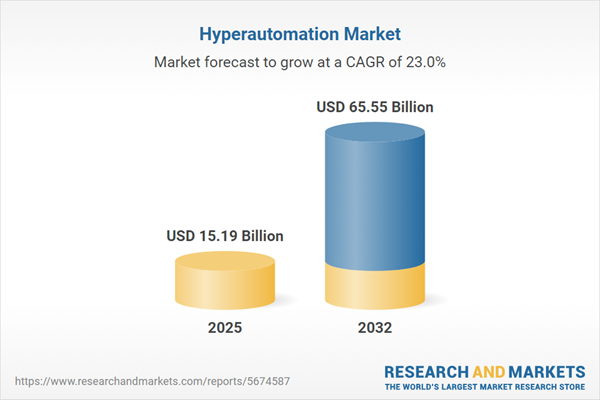Speak directly to the analyst to clarify any post sales queries you may have.
The hyperautomation market is undergoing significant transformation, offering forward-thinking organizations a way to achieve operational excellence and digital agility. Senior decision-makers are increasingly embracing unified automation strategies to streamline workflows and accelerate competitive differentiation.
Market Snapshot: Hyperautomation Market Size and Growth
The Hyperautomation Market grew from USD 12.47 billion in 2024 to USD 15.19 billion in 2025. It is expected to continue expanding at a CAGR of 23.04%, ultimately reaching USD 65.55 billion by 2032.
Scope & Segmentation
- Component: Services (Consulting, Implementation, Support & Maintenance); Software.
- Application: Accounting Automation, Chatbots, Customer Relationship Management, Feedback Automation, Invoice Processing, Lead Generation, Payroll Automation, Recruitment Automation, Supply Chain Management.
- Deployment Model: Cloud-Based, On-Premises.
- End-Use: Automotive, Banking, Financial Services & Insurance, Construction, Energy & Utilities, Healthcare, IT & Telecom, Manufacturing, Retail & E-Commerce, Telecommunications.
- Organization Size: Large Enterprises, Medium Enterprises, Small Enterprises.
- Regions: Americas (United States, Canada, Mexico, Brazil, Argentina, Chile, Colombia, Peru), Europe, Middle East & Africa (United Kingdom, Germany, France, Russia, Italy, Spain, Netherlands, Sweden, Poland, Switzerland, United Arab Emirates, Saudi Arabia, Qatar, Turkey, Israel, South Africa, Nigeria, Egypt, Kenya), Asia-Pacific (China, India, Japan, Australia, South Korea, Indonesia, Thailand, Malaysia, Singapore, Taiwan).
- Competitive Landscape: Companies analyzed include Aisera, Inc.; Box, Inc.; Celonis GmbH; Fortra, LLC; Google LLC by Alphabet Inc.; Infosys Limited; International Business Machines Corporation; Microsoft Corporation; Oracle Corporation; SAP SE.
Key Takeaways for Senior Decision-Makers
- The hyperautomation market is shaped by integration of AI, robotics, and analytics, driving scalable end-to-end process improvement across industries.
- Market leaders achieve differentiation by investing in unified automation frameworks, cross-functional orchestration, and adaptive governance models.
- Shift from isolated automation projects to holistic, modular platforms enables rapid implementation and greater business value realization.
- Professional services continue to be vital, guiding enterprises through deployment and ensuring optimal return as regulatory, compliance, and risk management needs intensify.
- Cloud-native architectures and embedded AI are reducing entry barriers, promoting adoption in both established and emerging markets.
- Regional innovation hubs are emerging, especially in Western Europe and Asia-Pacific, highlighting the importance of local context in global automation strategies.
Tariff Impact: Navigating Cost and Supply Chain Challenges
The 2025 United States tariff framework has led organizations to rethink procurement and vendor strategies in hardware-dependent automation. Increased duties on robotics components and sensors are driving a shift toward software-led solutions and modular, hardware-agnostic automation kits. Sourcing diversification and localized partnerships are becoming essential to minimizing cost volatility and supply chain risk for hyperautomation deployment in the U.S. and beyond.
Methodology & Data Sources
This report utilizes a robust, multi-stage research approach combining in-depth executive interviews, industry surveys, and comprehensive review of technology publications, regulatory filings, and patent databases. Analytical methods such as scenario analysis and SWOT assessment underpin all key findings, ensuring clarity and actionable insights.
Why This Report Matters
- Enables IT and business leaders to benchmark hyperautomation adoption strategies and evaluate evolving best practices for digital transformation.
- Empowers decision-makers to proactively navigate changing compliance, risk, and operational frameworks in light of evolving global and regional dynamics.
- Supports technology and procurement teams with actionable intelligence for selecting vendors, platforms, and service models suited to enterprise scale and vertical needs.
Conclusion
The hyperautomation market is pivotal for organizations aiming to achieve process excellence, enhanced compliance, and continuous innovation. This report delivers a foundation for informed decision-making and successful automation investment strategies.
Additional Product Information:
- Purchase of this report includes 1 year online access with quarterly updates.
- This report can be updated on request. Please contact our Customer Experience team using the Ask a Question widget on our website.
Table of Contents
3. Executive Summary
4. Market Overview
7. Cumulative Impact of Artificial Intelligence 2025
Companies Mentioned
The companies profiled in this Hyperautomation market report include:- Aisera, Inc.
- Box, Inc.
- Celonis GmbH
- Fortra, LLC
- Google LLC by Alphabet Inc.
- Infosys Limited
- International Business Machines Corporation
- Microsoft Corporation
- Oracle Corporation
- SAP SE
Table Information
| Report Attribute | Details |
|---|---|
| No. of Pages | 185 |
| Published | November 2025 |
| Forecast Period | 2025 - 2032 |
| Estimated Market Value ( USD | $ 15.19 Billion |
| Forecasted Market Value ( USD | $ 65.55 Billion |
| Compound Annual Growth Rate | 23.0% |
| Regions Covered | Global |
| No. of Companies Mentioned | 11 |









